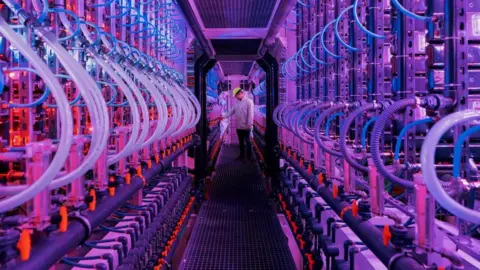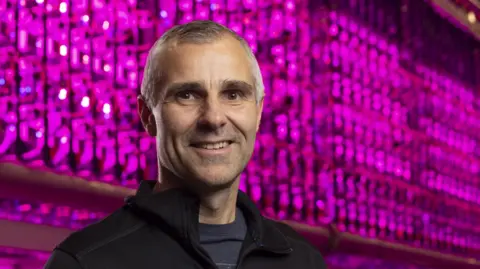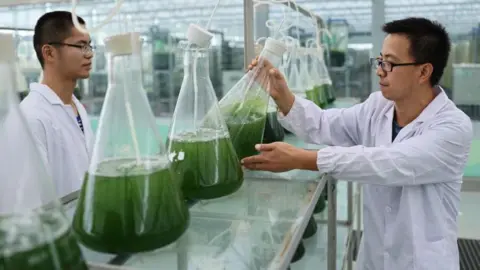Inside an Icelandic farm growing algae for food

 Vaxa
VaxaIn the shadow of Iceland’s largest thermal power station, a large barn houses a state-of-the-art indoor farm unlike anything I’ve ever seen.
Under a strange pink light, light panels rumble and cylindrical columns of water bubble, as the future algae plant grows.
It is here that Iceland’s Vaxa Technologies has developed a system that uses energy and other resources from a nearby power plant, to grow these tiny aquatic insects.
“It’s a new way of thinking about food production,” says general manager Kristinn Haflidason as she shows me the space-age space.
For most of our history, humans have eaten seaweed, also known as macroalgae.
But its smaller relative, microalgae has been an unusual food source, although it was eaten for centuries in ancient Central America and Africa.
Now scientists and entrepreneurs are increasingly exploring its potential as a nutrient-dense, sustainable food.
About 35 minutes from the capital Reykjavik, the Vaxa area produces the microalgae Nannochloropsis, both as human food, and as feed for fish and shrimp farming.
It also grows a type of bacteria called Arthospira, also known as blue-green algae, as it shares the same properties as microalgae.
When dried it is known as spirulina and is used as a food additive, food additive, and as a light blue food color.
These small organisms photosynthesize, taking energy from light to absorb carbon dioxide and release oxygen.
“Algae consume CO2, or convert CO2 into biomass,” explained Mr Haflidason. “It’s carbon negative.”
 Vaxa
VaxaVaxa’s plant has a unique shape.
It is the only place where the cultivation of algae is combined with a thermal power station, which provides clean electricity, brings cold water for cultivation, hot water for heating, and even pipes for all its CO2 emissions.
“You end up with a negative carbon footprint,” says Asger Munch Smidt-Jensen, a food technology consultant at the Danish Technology Institute (DTI), who co-authored a study examining the environmental impact of Vaxa’s spirulina production.
“We also found a very low-lying area, in terms of land and water use.”
Round-the-clock renewable energy, as well as CO2 fluxes, and low-carbon nutrients, are needed to ensure that the setup allows the climate, and he thinks that is not easily replicated.
“There is a large energy input to run these photo-bioreactors, and you have to simulate the sun artificially, so you need a high-power light source,” he explains.
“What I think most is that we should use these places [like Iceland] where we have a low impact on energy sources to make energy-intensive products,” added Mr. Munch Smidt-Jensen.
 Vaxa
VaxaBack at the algae plant, I climb to the top, where I am surrounded by noisy units called photo-bioreactors, where thousands upon thousands of small red and blue LED lights fuel the growth of microalgae, instead of sunlight.
They are also given water and nutrients.
“More than 90% of photosynthesis occurs between the red and blue wavelengths of light,” explains Mr Haflidason. “We only give them the light they use.”
All scenarios are tightly controlled and optimized by machine learning, he adds.
About 7% of the crop is harvested daily, and is quickly renewed with new growth.
The Vaxa facility can produce 150 metric tons per year, and plans to expand.
Since plants are rich in protein, carbohydrates, omega-3s, fatty-acids, and vitamin B12, Mr. Haflidason believes that growing microalgae in this way, can help address food insecurity around the world.
Many other companies are betting on the potential of microalgae – it is estimated that the market will be worth $25.4bn (£20.5bn) by 2033.
Danish start-up Algiecel has been testing portable shipping container-sized modules that house photo-bioreactors, and which can be connected to carbon-emitting factories to capture their CO2, while simultaneously producing food and feed.
Plants are also used for cosmetics, medicine, biofuel and plastic replacement.
Perhaps also microalgae can be produced in the atmosphere.
In a project funded by the European Space Agency, the Danish Technological Institution plans to test what microalgae can be. grew up on the International Space Station.
 Getty Images
Getty ImagesDespite all the investment, there is some way to go before microalgae become a daily part of our diet.
It still needs a lot of development, according to Mr. Munch Smidt-Jensen.
He points out that the texture lacks durability. Meanwhile the taste can be “fishy” if the algae is a saltwater variety.
“But there are ways to overcome this,” he adds.
There is also the question of society.
“Are people ready for you? How do we make everyone want to eat this?”
Malene Lihme Olsen, a food scientist at the University of Copenhagen who studies microalgae, says its nutrition needs more research.
“Green microalgae [chlorella] they have a strong cell wall, so it can be difficult for us to digest and get all the nutrients,” she said.
Currently he says microalgae are best added to other “carrier products” such as pasta or bread to help with taste, texture and appearance.
However, Ms. Olsen believes that microalgae are a promising future food.
“If you compare one hectare of soybeans in Brazil, and imagine that we have one hectare of algae field, you can produce 15 times more protein per year. [from the algae].”

Back at the plant I look at the unpleasant green sludge. It is a harvested microalgae that has been dewatered, ready for further processing.
Mr. Haflidason gives me a taste and, after initial hesitation, I try and find its taste neutral and texture similar to tofu.
“We’re not suggesting that anyone should eat green slime,” joked Mr Haflidason.
Instead, processed algae is an everyday ingredient, and in Reykjavik one bakery makes bread with Spirulina and a gym puts it in smoothies.
“We will not change what you eat. We will change the amount of food you eat,” he said.
Source link




